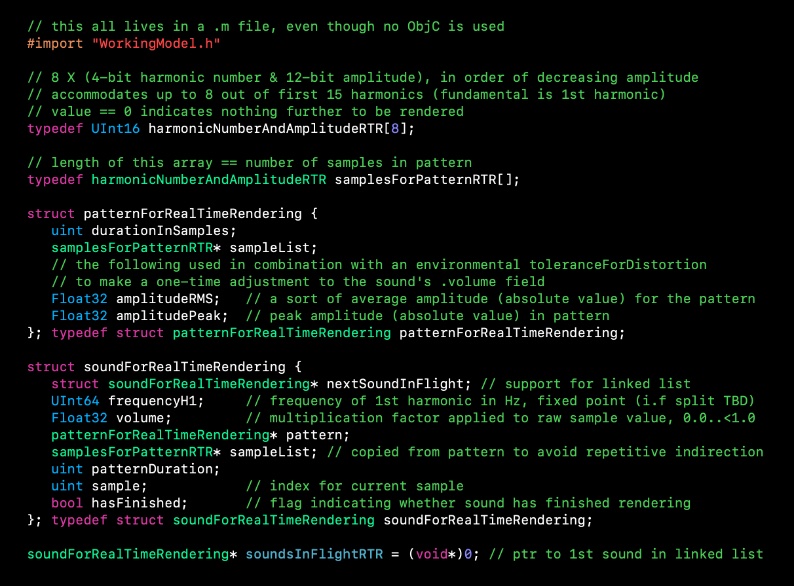After removing inessentials and considerable refactoring
switching to fixed-point for pitch and phase
but not for volume (not yet anyway)
switching to fixed-point for pitch and phase
but not for volume (not yet anyway)
As this stands,
those 12-bit amplitudes,
will need to be converted to floats
in order to be useful.
those 12-bit amplitudes,
will need to be converted to floats
in order to be useful.
Also, as it stands, I& #39;ve left out pitch-bending.
Admittedly this was inadvertent,
but I think I& #39;ll leave it out of the pattern
for the time being.
I don& #39;t want to complicate
samplesForPatternRTR[]
or the code that makes use of it,
and I have a different idea...
Admittedly this was inadvertent,
but I think I& #39;ll leave it out of the pattern
for the time being.
I don& #39;t want to complicate
samplesForPatternRTR[]
or the code that makes use of it,
and I have a different idea...
As previously mentioned,
one way of handling pitch-bending
is to add a second array pointer
to the pattern struct,
also copying that to the sound struct,
and use the same index for both.
one way of handling pitch-bending
is to add a second array pointer
to the pattern struct,
also copying that to the sound struct,
and use the same index for both.
In principle, this would allow
mix/matching harmonic amplitude patterns
and pitch-bending patterns of the same length,
but it& #39;s still doesn& #39;t make provision for
the interactivity I& #39;m after.
mix/matching harmonic amplitude patterns
and pitch-bending patterns of the same length,
but it& #39;s still doesn& #39;t make provision for
the interactivity I& #39;m after.
Also, that interactivity really should extend to
the net amplitude of the sound as a whole,
not just the pitch.
A different approach is called for...
the net amplitude of the sound as a whole,
not just the pitch.
A different approach is called for...
Pitch and amplitude variation
not resulting from harmonic interactions
constitute a distinct pattern,
brought to the instrument by the performer.
They need to be incorporated into the sound
in real time,
and also recorded for later reproduction.
not resulting from harmonic interactions
constitute a distinct pattern,
brought to the instrument by the performer.
They need to be incorporated into the sound
in real time,
and also recorded for later reproduction.
And my earlier concern about
(my default approach to)
pitch-bending resulting in artifacts
is not at issue here.
That& #39;s an implementation detail,
or, perhaps, more than a detail,
but it can only be addressed
in the render algorithm.
(my default approach to)
pitch-bending resulting in artifacts
is not at issue here.
That& #39;s an implementation detail,
or, perhaps, more than a detail,
but it can only be addressed
in the render algorithm.
Something else for the render algorithm...
Equalization...
Sure, you can pipe the output of a source node
though an equalizer node,
but this being generative sound,
using explicit frequencies,
you can also apply
frequency-dependent amplitude modification
in the source node.
Equalization...
Sure, you can pipe the output of a source node
though an equalizer node,
but this being generative sound,
using explicit frequencies,
you can also apply
frequency-dependent amplitude modification
in the source node.
...I can practically feel
the synaptic connections
being formed... ;-)
the synaptic connections
being formed... ;-)
Moreover, that
"frequency-dependent amplitude modification"
constitutes yet another distinct pattern,
to be mix/matched with
the pattern of harmonic amplitudes.
"frequency-dependent amplitude modification"
constitutes yet another distinct pattern,
to be mix/matched with
the pattern of harmonic amplitudes.
All these patterns
mean even more pressure on memory access,
necessitating even more emphasis
on efficiency.
I& #39;m in my element! ;-)
mean even more pressure on memory access,
necessitating even more emphasis
on efficiency.
I& #39;m in my element! ;-)
Recapping...
The voice of the instrument:
•distribution of energy (amplitude) through harmonics
•frequency-dependent amplitude modification
What the performer contributes (recordable):
•sound events
•real-time variation in pitch and amplitude
The voice of the instrument:
•distribution of energy (amplitude) through harmonics
•frequency-dependent amplitude modification
What the performer contributes (recordable):
•sound events
•real-time variation in pitch and amplitude
Strictly speaking, the performer also contributes real-time variation in the duration of sound events, and potentially also in the distribution of energy through harmonics, but incorporating these is more complication than I& #39;m willing to undertake for the time being.
That said, having recognized this
these factors will continue to gnaw at me
until I figure out
some way of making provision
for their future incorporation,
but that& #39;s just me...
these factors will continue to gnaw at me
until I figure out
some way of making provision
for their future incorporation,
but that& #39;s just me...

 Read on Twitter
Read on Twitter


